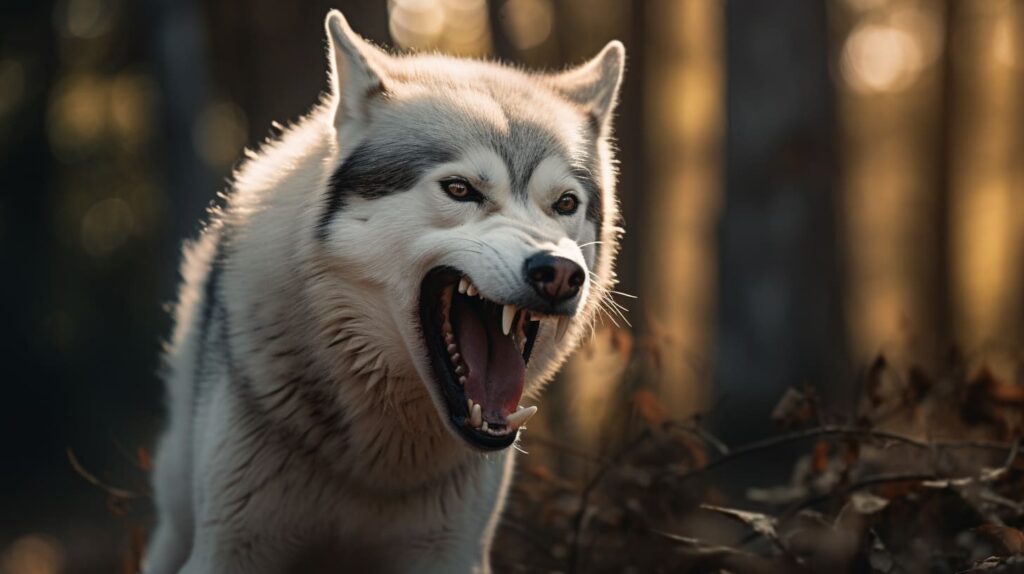Huskies: The Misunderstood Maestros of Mischief
Oh, those Huskies, with their piercing blue eyes and unparalleled energy, are the rock stars of the canine world. But just like your favorite lead guitarist, they come with a bit of a reputation – for being ahem a tad on the stubborn side. But let’s not jump to conclusions; instead, let’s dive into the Husky spirit symphony.
It’d be easy to mistake a Husky’s independent streak for stubbornness. But picture this – you’re a hardworking sled dog bred to make tough decisions in the icy tundras of Siberia. You’d want a bit of autonomy too. Our fluffy pals aren’t stubborn; they’re just brilliant and used to being in the driver’s seat. They’re like the four-legged equivalent of your favorite reality TV show – unpredictable but oh-so-entertaining.
But wait. Have you ever heard a Husky talk? No, they haven’t mastered the Queen’s English yet, but they have a unique way of communicating that often sounds eerily like human conversation. This isn’t a Husky being talkative; it’s a Husky being a Husky. It’s just another fun-fact icebreaker to throw out at your next dinner party. “Did you know my dog can talk?” is a guaranteed conversation starter. So, let’s embrace the Husky for what it is – a magnificent, misunderstood maestro of mischief with a talent for ‘talking.’
Understanding Aggression in Huskies
Hello, fellow Husky enthusiasts! Settle in, grab a cup of hot cocoa (or a doggy treat for your four-legged friend), and chat about our favorite drama-queen breed – the Huskies.
Aggression vs Assertiveness: Distinguishing the Line
First things first, let’s clear the air. We’ve all seen our Huskies throw a tantrum, playfully snap, or give us the ‘I’m the boss here’ look. But is this aggression or just Husky assertiveness? It’s as tricky as separating two entwined chew toys from your Husky’s determined grip!
Assertiveness is your Husky saying, “Hey, I’ve got opinions too, you know!” It’s like them wanting to pick the movie for the night (and it’s always ‘Lady and the Tramp’). Aggression, on the other hand, is more serious. It’s like them deciding they’re the movie critic and biting every DVD they don’t fancy.
Root Causes: Why Your Husky Might Display Aggression
So, what turns our fluffy, lovable, sled-pulling pals into the occasional Cujo? To answer that, we need to dig a little into the Husky psyche (don’t worry, there are no Freudian theories here).
Some Huskies had negative experiences that led them to react aggressively as a defense mechanism – like us when someone tries to steal the last slice of pizza. Others might be feeling unwell or in pain. You’d probably understand if you suddenly turned into a growling beast every time a migraine hit.
And then there’s the territorial aggression. This is the “This is Sparta!” moment for your Husky when they feel their personal space (or favorite squeaky toy) is threatened.
The Humorous Side-Look: Huskies and Their Drama-Queen Moments
But let’s not forget the more humorous side of Husky “aggression.” These fur babies are known to be the Meryl Streeps of the dog world. Their dramatic sighs, eye-rolls, and ‘talk-backs’ can rival teenagers. Yes, they might snarl at you when you try to move them off the couch, but we all know they’re just being divas.
Remember when your Husky flopped onto the floor, crying and howling, just because you wouldn’t share your ice cream? Or when they ‘argued’ with you about their bedtime? These moments might seem aggressive, but they’re just your Husky’s saying, “Look at me! I’m cute, and I know it!”
So, to wrap it up, understanding aggression in Huskies is like trying to decode a foreign film without subtitles. It’s confusing, hilarious, and sometimes a bit scary. That’s why we love our Huskies, right? Their spunk, their spirit, and yes, even their drama-queen moments make every day an adventure.
Prevention Starts at Puppyhood
Oh, those Husky puppies, right? With those piercing blue eyes and adorable fluff balls of fur, it’s no wonder they grab your heart at first sight! But remember, my fellow Husky enthusiast, that this cute little bundle of joy comes with a certain… shall we say, ‘spirited’ personality. So, let’s dive into the depths of the Husky world and explore how prevention of behavioral issues starts at puppyhood.
Socialization: The Key to a Well-Behaved Husky
Let’s face it: Huskies are social butterflies! They’re the life of the party, the ones who are always ready for a good time. But, just like humans, they need to learn the dos and don’ts of social etiquette. This is where socialization, that big word that means ‘learning to play nice,’ comes into play.
Start as soon as your vet gives the go-ahead. Walk your Husky puppy in different environments. Introduce them to various people and animals. Let them experience other sights, sounds, and smells. Remember, we’re not just raising a dog here; we’re shaping a tiny, furry citizen of the world!
Training Techniques: Making It a Game, Not a Chore
Alright, let’s talk training. Now, before you groan and imagine hours of ‘sit,’ ‘stay,’ and ‘heel,’ let me stop you. Training your Husky should not be a chore. Think of it as a fun game – a bonding experience.
Huskies are intelligent, and boy, do they know it! They can be stubborn and independent, which makes training a challenge. But don’t be discouraged. The trick is to make it engaging and rewarding. Use positive reinforcement techniques like treats, toys, or praise — whatever tickles your Husky’s fancy.
And remember, consistency is critical. Your Husky is a smart cookie and will quickly catch on to any inconsistencies in your training. So, stick with it, make it fun, and before you know it, your Husky will be an obedient, well-trained family member.
Communication and Your Husky: Speaking ‘Dog’
So, you’ve got a Husky. And let’s be honest, who wouldn’t want one? They’re like the heartthrobs of the dog world – those piercing blue eyes, that thick, luscious fur, and an undeniable sense of adventure. But just like any Hollywood A-lister, these cuties come with their language. So, let’s dive right into the world of Husky talk and crack this canine code together.
Understanding Your Husky’s Body Language
First things first, let’s talk about body language. Just like humans, dogs speak volumes through their actions. They might be unable to pen a sonnet about their feelings, but those wagging tails and perked ears are their version of Shakespeare.
When your Husky’s tail is high and wagging, it’s their way of saying, “Hey, I’m in a good mood; let’s play fetch or maybe take a run in the park!” Their ears perked up? That’s doggie for, “I’m alert and interested, what’s going on?” But if those ears are flat against their head, let’s say they’re having a bit of a ‘ruff’ day.
Responding to Aggression: Do’s and Don’ts
Now, let’s touch on the not-so-fun part – aggression. It’s like the dog version of a Twitter feud, and trust me, you do not want to be on the receiving end of that.
So, what do you do when your Husky shows aggression? First off, don’t panic. It’s like dealing with a faulty WiFi connection – frustrating but manageable.
Do try to understand the cause. Maybe the poor thing is scared or unwell. Don’t punish them physically or yell at them. That’s like trying to put out a fire with gasoline. Instead, calmly remove them from the situation and consult with a professional if needed.
Chuckles from the Dog Park: Misinterpretations of Husky ‘Talk’
Lastly, let’s laugh at the common misinterpretations of Husky talk. How often have you seen a Husky howling and thought, “Oh, they must be angry!” Well, they might be singing their version of ‘Bohemian Rhapsody.’
Huskies are known for their unique vocalizations. They howl, whine, and sometimes even ‘talk.’ But these sounds often need to be more understood. A howling Husky isn’t necessarily upset; sometimes, they feel chatty.
So, don’t jump to conclusions the next time you hear that iconic Husky howl. They might be trying to tell you about their day or just singing along to the radio.
Communication is vital in any relationship, even with your four-legged friend. So take the time to understand your husky, and you’ll speak ‘dog’ in no time!
Training Techniques to Prevent Aggression
Alright, fellow dog lovers, let’s train our furry pals. Because, let’s face it, nothing spoils a good game of fetch like a sudden about of doggy aggression. Thankfully, I’ve got five proven techniques to help you and your canine companion keep the peace.
Positive Reinforcement: Rewarding the Good, Ignoring the Bad
Let’s kick things off with a fan favorite – positive reinforcement. It’s as simple as it sounds! You reward your dog when they’re being the canine angel you know they can be, and ignore them when they’re having a bit of a devilish moment. Think of it as the ‘doggy time-out’ — no treats, no attention, nada.
When your dog does something you like, shower them with praise, treats, belly rubs, you name it. If they’re being naughty, ignore them completely. You wouldn’t reward a child for throwing a tantrum in the middle of a grocery store, would you? Same concept. Dogs, like children, crave attention. You’re teaching them that good behavior equals love and treats by only giving them attention when they’re behaving. And let’s be honest, what dog doesn’t love a good treat?
Consistency is Key: Making Training a Routine
Next up on our training techniques parade is consistency. Dogs are creatures of habit, and they love routine. Waking up at the same time, eating at the same time, walking at the same time — you get the picture. Practices make them feel secure and in control. So, make training a part of their daily routine.
And I’m not talking about a “once-in-a-blue-moon” consistency here. It would be best to be as regular as that morning cup of joe you can’t live without. The more consistent you are with your training, the more your puppy will likely remember the good habits you’re teaching them.
Healthy Lifestyle, Happy Husky
Let’s face it – who wouldn’t want their husky to be the happiest dog on the block? Like humans, our four-legged friends need their daily dose of exercise, a well-balanced diet, and the occasional thrilling adventure to keep them on their toes (or paws). Let’s dive into husky wellness and discover what it takes to keep your furry friend’s tail wagging!
Exercise is Essential: Keeping Your Husky Fit and Content
Huskies are not your average couch potatoes – they’re go-getters, full of energy, and always ready for action. If you thought your morning jog was challenging, try keeping up with a husky! These energetic furballs need their daily dose of exercise to avoid turning into the canine version of a whirlwind in your living room.
Think of your husky as a furry athlete – they must train to keep in shape. Whether it’s a game of fetch in the park, a vigorous tug-of-war session, or a good old-fashioned hike, make sure your husky gets his heart pumping. Remember, a tired husky is a good husky; by ‘good,’ we mean less likely to use your favorite pair of shoes as a chew toy.
Balanced Diet: What’s in Your Husky’s Bowl?
Like humans, Huskies can’t live on love and air alone. They need a balanced diet to fuel their energetic lifestyle. A healthy husky diet is more than just kibble and water. It’s about feeding them the right food in the right amounts at the correct times.
But what exactly does ‘the right food’ mean? Your husky needs a mix of proteins, carbs, fats, vitamins, and minerals. Think of it as a dinner plate – you wouldn’t want to eat only peas for dinner. Your husky feels the same way. They need variety and balance in their diet.
And remember, while those puppy dog eyes might be hard to resist, avoid giving in to their pleas for table scraps. Your lasagna might be delicious, but it could be more husky-friendly. Stick to dog-friendly foods, and your husky will thank you (probably with a big, wet lick to the face).
The Unexpected Husky Adventure: When Walks Turn Into Marathons
With a husky, a simple walk around the block can turn into an epic adventure. One moment, you’re strolling along the sidewalk; the next, you’re sprinting after a squirrel or exploring the neighborhood’s hidden trails.
Huskies are curious creatures with a knack for making the ordinary extraordinary. They love to explore and have a wild streak. Isn’t that why we love them?
Just remember to keep your husky leashed when you’re out and about. While they might be having the time of their life, you don’t want your walk to turn into a game of ‘catch the husky.’
And there you have it – the recipe for a happy, healthy husky! Exercise, a balanced diet, and a dash of adventure are all it takes. Happy husky-ing!
Seeking Professional Help: When to Call in the Cavalry
So, you’ve got a Husky. Congratulations! They’re a bundle of joy, aren’t they? But maybe your bundle of joy is showing signs of not-so-joyful behavior. Don’t worry, we’ve all been there…and some of us have chewed-up leashes to prove it.
Recognizing Signs of Serious Aggression
Let’s start with the serious stuff. Aggression. Now, I know what you’re thinking. “My Husky? Aggressive? Never!” But hear me out. Sometimes, our fluffy friends can show signs of aggression. It might be a low growl when you try to take away their favorite toy or a snarl at the mail carrier. But how do you distinguish between normal dog behavior and a sign you might need to call the cavalry?
Watch for consistent, aggressive behavior like growling, baring teeth, lunging, or biting. If you observe any of these signs consistently, it’s time to seek professional help. Remember, aggression in dogs is like a smoke alarm. You wouldn’t ignore a smoke alarm, would you? No! You’d call the fire department. Or at least grab a fire extinguisher.
Choosing the Right Trainer or Behaviorist
Okay, so you’ve decided to call in the cavalry. Good for you! But how do you choose the right professional for your Husky? Should you go for a trainer or a behaviorist?
A trainer might be the best fit for dealing with fundamental obedience issues. They can teach your Husky to behave, sit, stay, and fetch your slippers. However, a certified behaviorist might be your best bet if you’re dealing with aggression or other complex behavior issues. They’ve got the skills to dig deeper and find out what’s causing your Husky’s behavior, like a doggy detective.
Key Points: Preventing Aggression in Huskies
| Key Points | Details |
|---|---|
| Understanding Husky Behaviour | Huskies are energetic and playful and require mental and physical stimulation. Understanding their unique behavior helps prevent aggression. |
| Proper Training | Training should start early and should be consistent. Use positive reinforcement techniques to encourage good behavior. |
| Socialization | Regularly socialize your husky with other dogs and people to prevent aggression. This helps them learn how to behave in different situations. |
| Healthy Diet | A balanced and nutritious diet can affect a dog’s mood and behavior. Ensure your husky is getting the right nutrients to prevent aggression. |
| Regular Exercise | Huskies are active and require regular exercise to burn off energy. A lack of exercise can lead to frustration and possible aggression. |
| Mental Stimulation | Along with physical exercise, huskies also need mental stimulation. This can be achieved through puzzle toys, training, and games. |
| Avoid Punishment | Punishing a husky can lead to fear and aggression. Instead, use positive reinforcement to correct unwanted behaviors. |
| Regular Veterinary Checkups | Regular vet checkups can help detect any health issues causing aggression in your husky. |
| Professional Help | If aggression persists, consider seeking help from a professional dog trainer or a behaviorist. |
Tips for Preventing Aggression
Hello there, my fellow Husky enthusiasts! Owning a Husky is like having a furry, four-legged cyclone in your house. They’re full of energy, smart as a whip, and have more personality in their little paw than most people have in their entire bodies. But sometimes, that enthusiasm can cross the line into aggression.
Now, don’t worry. I’m not here to tell you you’ve adopted a cold-hearted Siberian assassin. Far from it! I’m here to share a few tips and tricks I’ve learned to help ensure your Husky remains the loveable, fluffy goofball we all know and love. So please put on your snow boots, grab a cup of hot cocoa, and dive into the beautiful world of Husky behavior!
- Early Socialization is Key: Like a young Jedi, your Husky needs to learn the ways of the Force early. That means exposing them to various people, places, and situations while still a puppy. The more they see the world, the less likely they will react with fear or aggression later.
- Consistent Training is Essential: Huskies are like teenagers – they’ll test your limits if you let them. Consistent, positive reinforcement-based training is crucial to remind them who’s boss (hint: it’s not them, despite what they might think!).
- Exercise, Exercise, Exercise: Remember that energy I mentioned earlier? It’s got to go somewhere! Regular physical activity not only keeps your Husky healthy, but it also helps to curb aggression by burning off that excess energy.
- Keep Calm and Carry On: Huskies are sensitive souls. They’re like the mood rings of the dog world – they’ll often reflect the energy and emotions of their owners. So if you’re calm and relaxed, they will be too.
- Regular Vet Check-ups: Sometimes, aggression can indicate an underlying health issue. Regular vet check-ups will help to ensure your Husky is in tip-top shape and not acting out due to discomfort or pain.
- Remember, Patience is a Virtue: Training a Husky can be like trying to herd cats – frustrating but hilarious. Remember to keep your sense of humor and be patient. Progress might be slow, but it’ll be worth it.
So there you have it, folks—the lowdown on keeping your Husky happy, healthy, and well-behaved. Remember, every Husky is unique, so feel free to tweak these tips to suit your furry friend. Happy trails, Husky herders!






